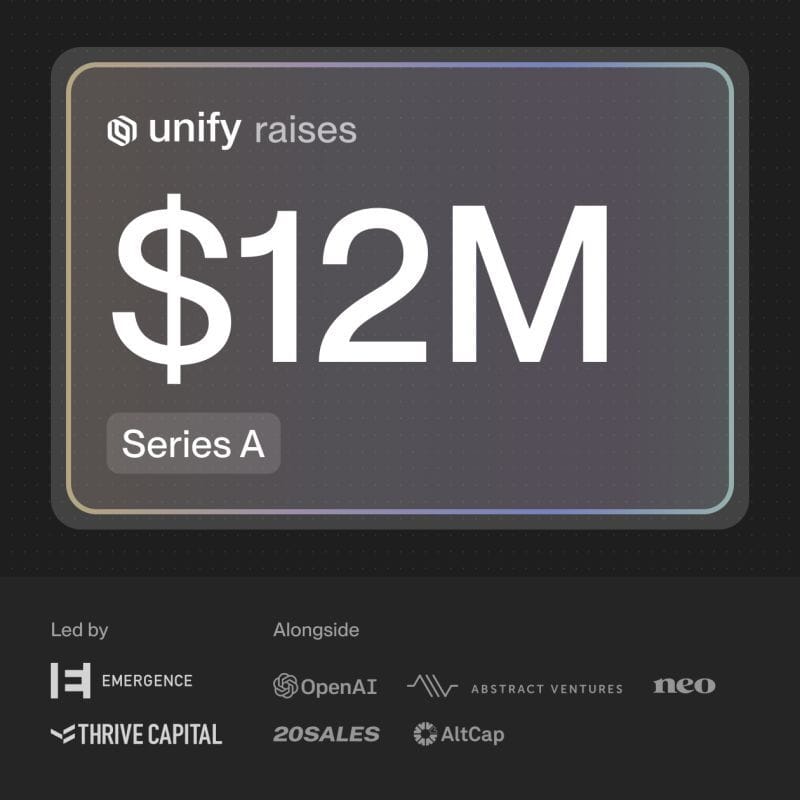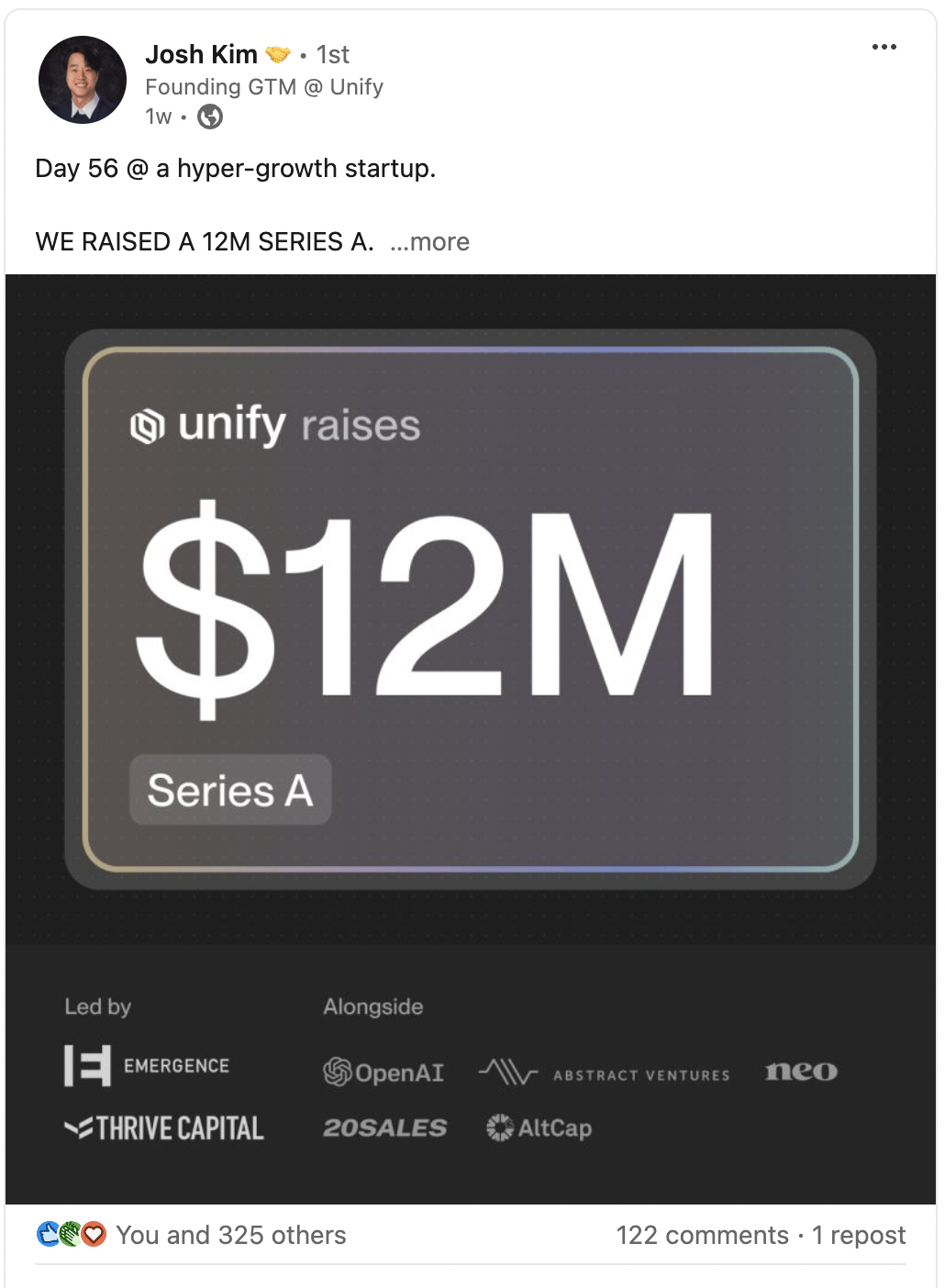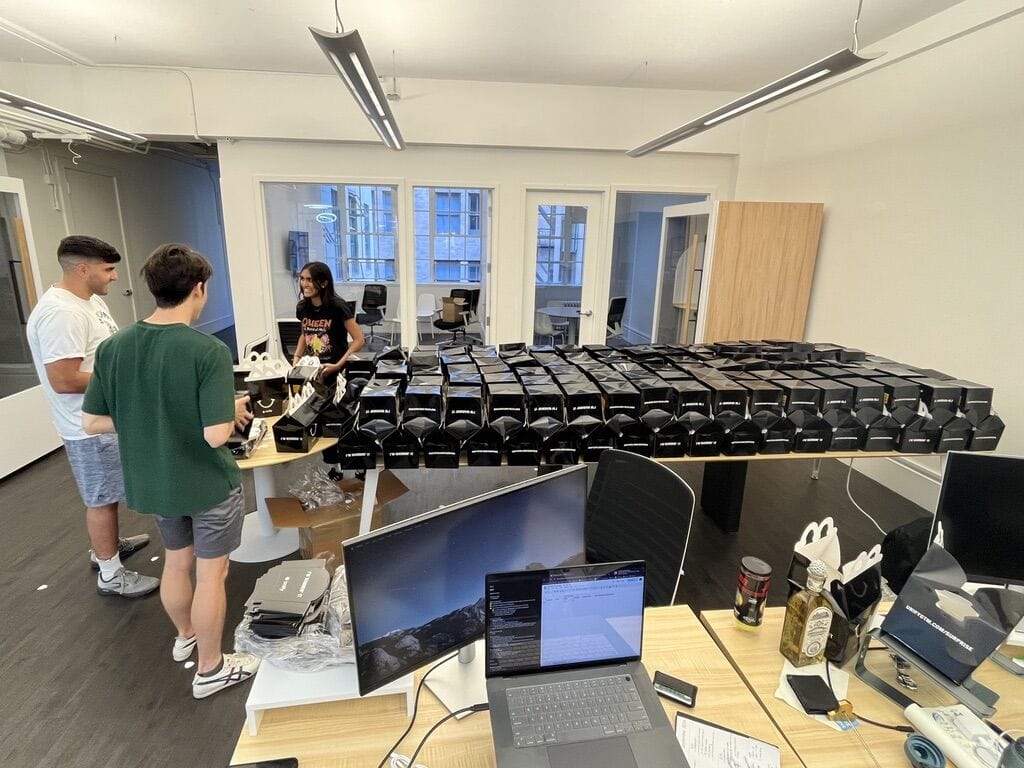- Social Files by Tommy Clark
- Posts
- How Unify used LinkedIn to drive $2M in pipeline and 208 inbound demos
How Unify used LinkedIn to drive $2M in pipeline and 208 inbound demos
The art of the B2B fundraising announcement

Hey!
Welcome to Social Files—your no-BS guide to generating demand for your B2B product using social & content.
Hope you had a great weekend. 2 big notes from me:
We have a sick Bluecast feature dropping tomorrow. If you want to see it first, cop a 7-day trial here.
Pulled the trigger on signing up for the Austin half marathon. Inching closer and closer to falling down the running rabbit hole again. Lol.
Now, today’s piece. Got a good one for you on how to maximize one of the best opportunities you’ll have as a company to create a massive amount of hype (and inbound).
Shall we?
🔎 DEEP DIVE
How Unify used LinkedIn to drive $2M in pipeline and 208 inbound demos
The art of the B2B fundraising announcement

Every startup has a handful of built-in opportunities to create a ton of hype, and get a ton of inbound, from social.
Fundraising announcements are one of those opportunities.
I saw this back when I was Head of Social at Triple Whale. When we announced our seed round and our Series A, metrics shot up and to the right.
I see the same with our clients at Compound. One of them—Unify—announced their Series a ~2 weeks ago. In the days after the announcement, they generated 208 inbound demos.
This doesn’t happen by accident. Austin Hughes, Unify’s CEO, gets content. Everything around this announcement was meticulously planned.
And today, I want to walk you through 3 strategies in particular that you can steal.
Put a disproportionate amount of effort into the main announcement post.
Austin didn’t leave the performance of the fundraising post up to chance.

He was meticulous about every facet of the post—the hook, the body copy, the imagery, the distribution strategy.
I remember us having a conversation about the graphic choice in the days leading up to the post. Usually, I don’t see branded graphics hit that well on LinkedIn—usually, IRL photos do better, as they look less like ads.
Fundraising announcements are an exception to this. You want to make it so obvious that the post is a fundraising announcement. And if we’d gone with an IRL photo of the team, the announcement might have been missed by a reader.
So, we opted to go for a branded graphic that led with the amount raised, along with prominent investor logos to create more social proof.

The post itself is one half of the equation. The other half is the distribution strategy. Again, you don’t want to leave the outcome here up to chance.
Austin said “7 days before the announcement we emailed our investors and let them know about the social push and how they could help. We also sent calendar invites so no one would forget.”
The first 30-60 minutes after a post hits the timeline are crucial. You want to get as much momentum as you can early, so the algorithm pushes your post.
So by keeping investors in the loop on when the post was going live, Unify algorithm-proofed the announcement.
This is a smart play for any sort of launch. I did the same with Bluecast. Tap into your network. Fundraising announcements or major launches are the time to call in favors.
Use your team to create an echo chamber.
Austin’s post wasn’t the only one pushing the fundraising announcement.
Of course, the brand account posted. But, more importantly, pretty much every Unify team member made their own original post announcing the fundraise.
Important note here: this wasn’t some copy-paste “employee advocacy” BS. Each of the posts from team members was original, with a unique angle.
According to Austin, “3 weeks before launch we asked our 20-person team to spend 1-2 hours thinking + writing a social post.”
Skyler Mickunas published a post talking about his experience as Unify’s first GTM hire.

Another one of their founding GTM hires, Josh Kim, has been documenting his experience at Unify in a daily LinkedIn series. He integrated the fundraise announcement into the series, and it ripped—hitting 322 likes and 100+ comments.

Their founding engineer, Solomon Astley, posted about why he chose to join Unify.

The list goes on. But, see how each of these posts is unique? Each piece of content gives a reader a real reason to stop scrolling.
Too many startups try to ‘hack’ employee content. Instead, build your startup with a culture that encourages content creation. That’s the real hack.
Takeaway: Next time you have a big announcement, like a fundraise, ask your team members to write an original post. The best angle for this is to have them write about their experience in the launch.
For example, your Head of Marketing might write about their experience building the marketing engine for your company. Or your VP of Sales might write about their experience closing your first few customers.
Whatever you do, don’t HR-ify the launch by using some ‘employee advocacy’ tool. Ew.
Ride the wave.
You just put in all this effort to go niche viral on LinkedIn for the fundraise.
Don’t let the momentum die!
You have a golden window ~1 week post-announcement to ride the wave of hype you’ve created. Unify nailed this. Here’s what they’ve posted since announcing the raise:
“1 - A results recap 48 hours after announcement
2 - A highlight post on our Unify Happy Meal campaign
3 - 2 new product highlights for Unify Plays and AI Agents
4 -An announcement about a new team member”
Two threads I want to pull on here.
First, fundraising announcements create a lot of top-of-funnel hype. It’s smart to capitalize on this by shoehorning bottom-of-funnel product content in to convert some of that traffic.
As Austin noted, he publishes 2 new product highlights. This likely drove a good chunk of those 208 demos.
Second, I love the IRL “Happy Meal” campaign they executed. The Unify team sent 300+ Unify-branded happy meal boxes to prospects.

To track the reactions, Austin said “We created a custom landing page (unifygtm[dot]com[slash]surprise) and created an Audience in Unify to see which companies had received the boxes.”

Super smart. The campaign was reminiscent of the Antimetal pizza box campaign from a few months back—that netted them $1M in pipeline.
Takeaway: Think of your fundraise campaign in phases. Pre-announcement, announcement, and post-announcement.
Prepare your team to be involved in the content strategy. Be meticulous with the launch post itself. And use the post-announcement hype to drive more impressions and inbound—perhaps with some sort of IRL activation in conjunction with the social content.
Final thoughts
If there’s one lesson from this case study, it’s this: great social performance doesn’t happen by accident. This is true whether we’re talking about a funding announcement or an evergreen campaign.
For social content to drive inbound, the content-first mentality needs to be ingrained in the DNA of your company. It can’t be an afterthought.
That’s all I’ve got for today.
🗃 FILE CABINET
Here’s my favorite marketing and business content I bookmarked this week.
How to go from 0 to 5,000 followers on Linkedin in less than 6 months by Tommy Clark 🎥
Alex Hormozi’s Advice on SaaS by Tommy Clark 🎥
The Missing Piece to 2X Your Revenue by Leila Hormozi 🎥
Check these out.
BEFORE YOU GO…
As always, appreciate you trusting me with this valuable real estate in your inbox.
I enjoy writing these every week. And I’m glad you (at least somewhat) enjoy reading them.
Talk soon,
Tommy Clark
PS: Check out Bluecast with a 7-day trial here (no CC required).
PPS: If you want Compound to run a founder-led content motion for you… save a spot on our waitlist here. We’re at capacity through August, but looking to partner with some SaaS startups in November.